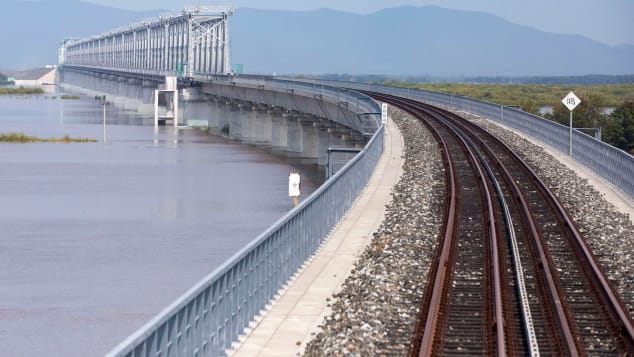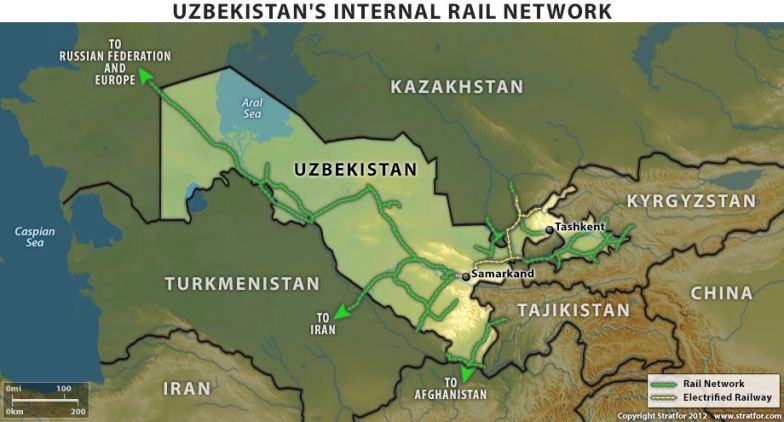 The new railway bridge across Amur River connecting Nizhneleninskoye (Russia) with Tongjiang (China) commissioned in August, is a technology demonstrator for so-called dual-track system.
The new railway bridge across Amur River connecting Nizhneleninskoye (Russia) with Tongjiang (China) commissioned in August, is a technology demonstrator for so-called dual-track system.
34. Central Asia hooking up to CPEC
The information war is so intense nowadays that unsung melodies are often more alluring that the sung ones. The lines from English poet Shelley’s famous ode To a Skylark come to mind — ‘In the broad day-light / Thou art unseen, but yet I hear thy shrill delight…’
Two events in the past fortnight indicated growing optimism about Afghanistan’s future. Both developments signify that the scaffolding for improved regional connectivity, economic development, and governance is coming up, largely unreported.
Certainly, the three-day visit to Islamabad in early November by Uzbekistan’s National Security Advisor Lt. Gen. Victor Makhmudov at the invitation of Pakistan’s NSA Moeed Yusuf deserved far more attention than it did. Prime Minister Imran Khan and Army Chief General Qamar Bajwa received the Uzbek delegation.
Uzbekistan is an advanced model of state formation in the post-Soviet space. The full control to exercise national security powers vested with the institution of the National Security Council in Tashkent under the chairmanship of the president gives remarkable consistency to the country’s policies. Makhmudov is holding his position since 2013.
Abdulaziz Kamilov has been Uzbekistan’s Minister of Foreign Affairs since 2012 — and is probably the most experienced foreign minister anywhere in the world if his nine years in a previous stint from 1994 to 2003 is also taken into account. No wonder, Uzbek foreign policies have been performing so brilliantly amidst a challenging external environment.
During Makhmudov’s visit, Pakistan has done well to sign a protocol with Uzbekistan, which “will help strengthen coordination on security and regional connectivity between our two brotherly countries,” as NSA Moeed Yusuf wrote in a tweet.
The official statement issued in Islamabad said the protocol “covers wide-ranging security-related matters of mutual interest and establishes coordination mechanism” between the two national security councils.
Yusuf told the media after the signing ceremony that the two countries would expand cooperation against terrorism, transnational crimes, drug trafficking under the new security commission, assist each other on anti-narcotics force and disaster management capacity building, and also strengthen defence and military cooperation.
To be sure, the developments in Afghanistan dominated the one-on-one meeting between Yusuf and Makhmudov. Yusuf said Islamabad and Tashkent “shared the same stance” on Afghanistan — namely, there should be constructive engagement with the current government in Kabul to avert a humanitarian crisis that could further severely affect the neighbouring countries.
Enhanced outreach to Central Asia under its geo-economics policy is a key objective for Pakistan. The Uzbek delegation travelled to the Torkham border to witness the arrival of four cargo trucks all the way from Uzbekistan via Afghanistan to Pakistan. In May this year, Pakistan’s first transport under the TIR system was sent to Uzbekistan via the land route.
As Yusuf put it, “Uzbekistan due to its close proximity with Afghanistan is a very crucial element in attaining our geo-economic paradigm.” This is a statement of fact. An ex-Soviet technocrat and a sports icon and playboy make improbable partners, but in reality, Uzbek president Shavkat Mirziyoyev and PrimeMinister Imran Khan have struck a warm friendship at personal level.
Personal equations at leadership level help advance geo-strategy in the steppes and both leaders are conscious of the imperatives of politics and economics that push them together. Thus was born the Uzbek-Pakistani home-grown approach to regional stability and economic growth.
Uzbekistan has prioritised transport through Pakistan to the ports of Gwadar and Karachi over the Chabahar route to the world market. Indeed, the US State Department was quick to realise this while announcing in July the US-Afghanistan-Uzbekistan-Pakistan Quad, “focused on enhancing regional connectivity” encouraging “long-term peace and stability in Afghanistan.” The US initiative would have rung alarm bells in Moscow and Beijing.
It is against such a dynamic background that the second development of the month, on November 8, needs to be assessed — the dramatic announcement by Kyrgyzstan’s Prime Minister Akylbek Zhaparov that Bishkek is ready to proceed with a long-standing project by Beijing to build a railway line to connect China with Uzbekistan.
The announcement, immediately after the visit of the Uzbek delegation to Islamabad, would suggest a nifty bit of sleight of hand on the part of Beijing working on the ‘big picture’ of the Taliban takeover in Afghanistan. Beijing (and Moscow) will have noticed the desperate Anglo-American mission to stage a comeback in Afghanistan.
The western media which copiously reports if Beijing sneezes, has blocked out Zhaparov’s announcement in Bishkek regarding the railway project. Zhaparov said his government has reached an agreement with Tashkent on all outstanding issues regarding the railway project and expects to do the same with Beijing in the near term, possibly during a high-level visit to the Chinese capital.

China appreciates that Uzbekistan has a fairly developed internal railway network and has potential as a regional hub. Thus, as part of its Belt and Road Initiative, China has longstanding plans to construct a railway from Xinjiang through Kyrgyzstan to Uzbekistan and onward to Turkmenistan (and Iran.) The main hitch has been that Beijing insisted that the new rail line should adopt tracks with 1,435 millimetres width, which China and most of the world use, while the Soviet-era Russian gauge of 1,520 millimetres is prevalent in Central Asia.
Trust Chinese ingenuity to find a technological solution by double-tracking with the narrower international gauge run inside the larger Russian one, which would also reduce costs of the project by eliminating the need to make transitions at the Chinese-Kyrgyzstani and Turkmenistani-Iranian borders.
In fact, a 2.2 kilometre long Sino-Russian Tongjiang-Nizhneleninskoye railway bridge across the Amur River, the latest project completed under China’s ambitious Belt and Road initiative, has become a ‘technology demonstrator’ using the new method of double tracking.
The first test train crossed the border in August. The Chinese Communist Party has stated at the goal a rail link all the way to London. With the commissioning of the bridge, the railway transportation distance from China’s Heilongjiang province to Moscow will be shortened by 809 kilometres, cutting 10 hours of transportation time.
Iron ore will be the main product carried across the bridge, which has an annual designed cargo capacity of 21 million tons. And, importantly, the railway bridge has a dual track system, which allows trains running on both the Russia gauge and the Chinese gauge!
Bishkek’s clearance for the Chinese railway project can phenomenally transform the cross-border connectivity in the Central Asian region and a host of regional states, including Afghanistan, Pakistan and Iran. The geopolitics of the region will never be the same again.
Uzbekistan is a great beneficiary here, being the principal gateway to Afghanistan and Pakistan (Gwadar and Karachi ports) and Pakistan becoming a pivotal state in regional politics. In March, Pakistan, Uzbekistan, and Afghanistan agreed to a roadmap for the building of a 573-kilometre route from Mazar-e-Sharif to Peshawar, via Kabul. The project, at an estimated cost of US$5 billion, will open Pakistani seaports on the Arabian Gulf to Uzbekistan.
From the Russian viewpoint, as the proposed Central Asian rail grid gets connected to the Russian grid. The rail link would have a multiplier effect on Russian capability to tap into Afghan reconstruction.
The criticality of the Afghan situation is compelling the Central Asian states to edge closer and China and Russia to intensify their cooperation and coordination to strengthen regional security. Not to be underestimated is the Uzbek-Kyrgyz agreement in March to resolve their 30-year border dispute at Tashkent’s initiative, which is a prerequisite for the China-Kyrgyzstan-Uzbekistan railroad.
To be sure, there is an all-round realisation amongst the main protagonists — principally, amongst China, Uzbekistan and Pakistan –that regional connectivity and long-term peace and stability in Afghanistan are inter-linked.
